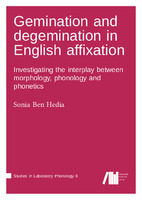Gemination and degemination in English affixation
Investigating the interplay between morphology, phonology and phonetics
| dc.contributor.author | Ben Hedia, Sonia | |
| dc.date.accessioned | 2020-03-10 03:00:38 | |
| dc.date.accessioned | 2020-04-01T09:14:45Z | |
| dc.date.available | 2020-04-01T09:14:45Z | |
| dc.date.issued | 2019-07-30 | |
| dc.identifier | 1006726 | |
| dc.identifier | OCN: 1196138036 | |
| dc.identifier.issn | 2363-5576 | |
| dc.identifier.uri | http://library.oapen.org/handle/20.500.12657/23424 | |
| dc.description.abstract | In English, phonological double consonants only occur across morphological boundaries, for example, in affixation (e.g. in unnatural, innumerous). There are two possibilities for the phonetic realization of these morphological geminates: Either the phonological double is realized with a longer duration than a phonological singleton (gemination), or it is of the same duration as a singleton consonant (degemination). | |
| dc.language | English | |
| dc.relation.ispartofseries | Studies in Laboratory Phonology | |
| dc.subject.classification | thema EDItEUR::C Language and Linguistics::CF Linguistics | en_US |
| dc.subject.other | Linguistics | |
| dc.title | Gemination and degemination in English affixation | |
| dc.title.alternative | Investigating the interplay between morphology, phonology and phonetics | |
| dc.type | book | |
| oapen.identifier.doi | 10.5281/zenodo.3232849 | |
| oapen.relation.isPublishedBy | 0bad921f-3055-43b9-a9f1-ea5b2d949173 | |
| oapen.relation.isFundedBy | b818ba9d-2dd9-4fd7-a364-7f305aef7ee9 | |
| oapen.relation.isbn | 9783961101887 | |
| oapen.place.publication | Berlin | |
| oapen.grant.number | 104947 | |
| oapen.grant.program | Language Science Press 2018 - 2020 | |
| oapen.identifier.isbn | 9783961101887 | |
| grantor.number | 104947 |

